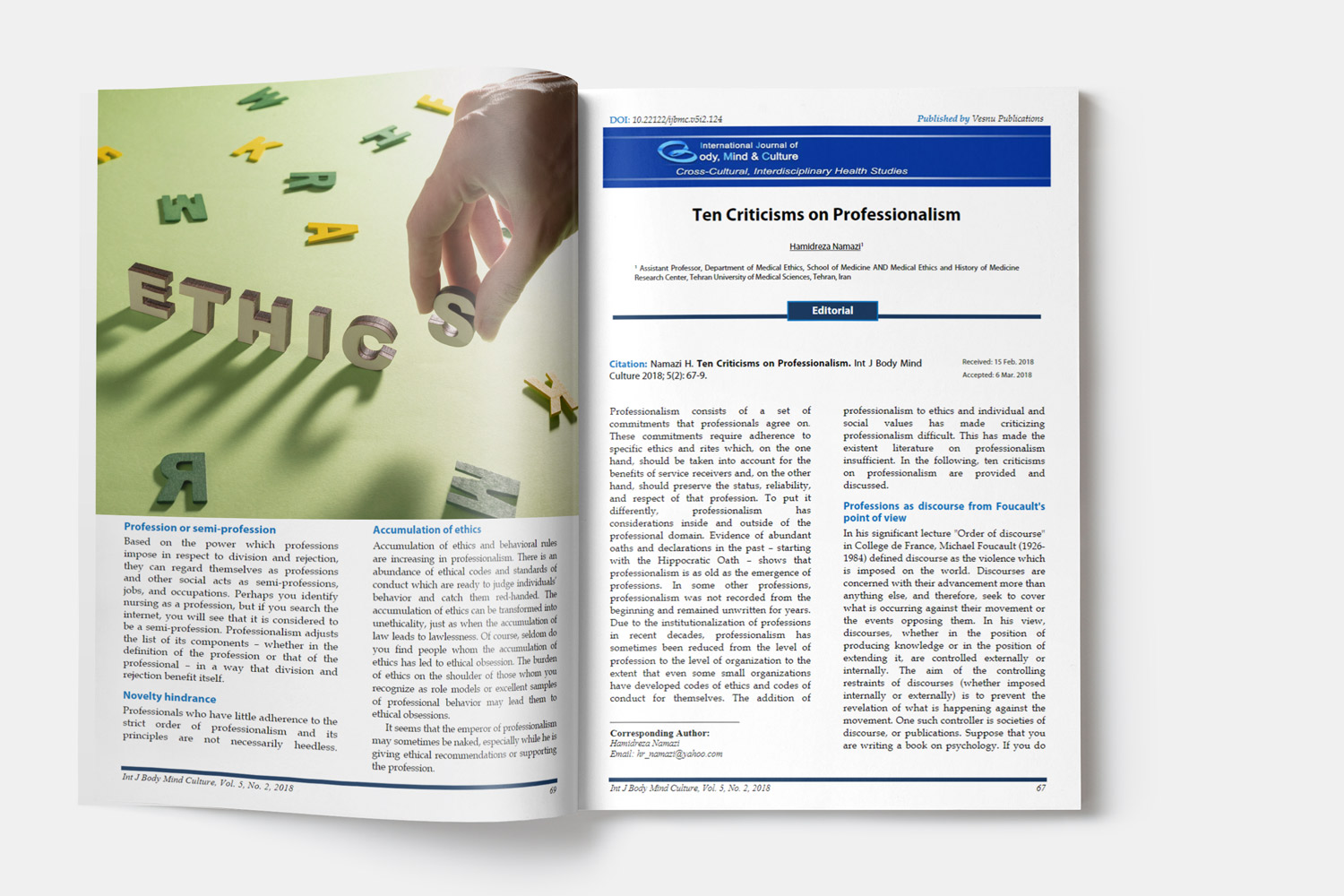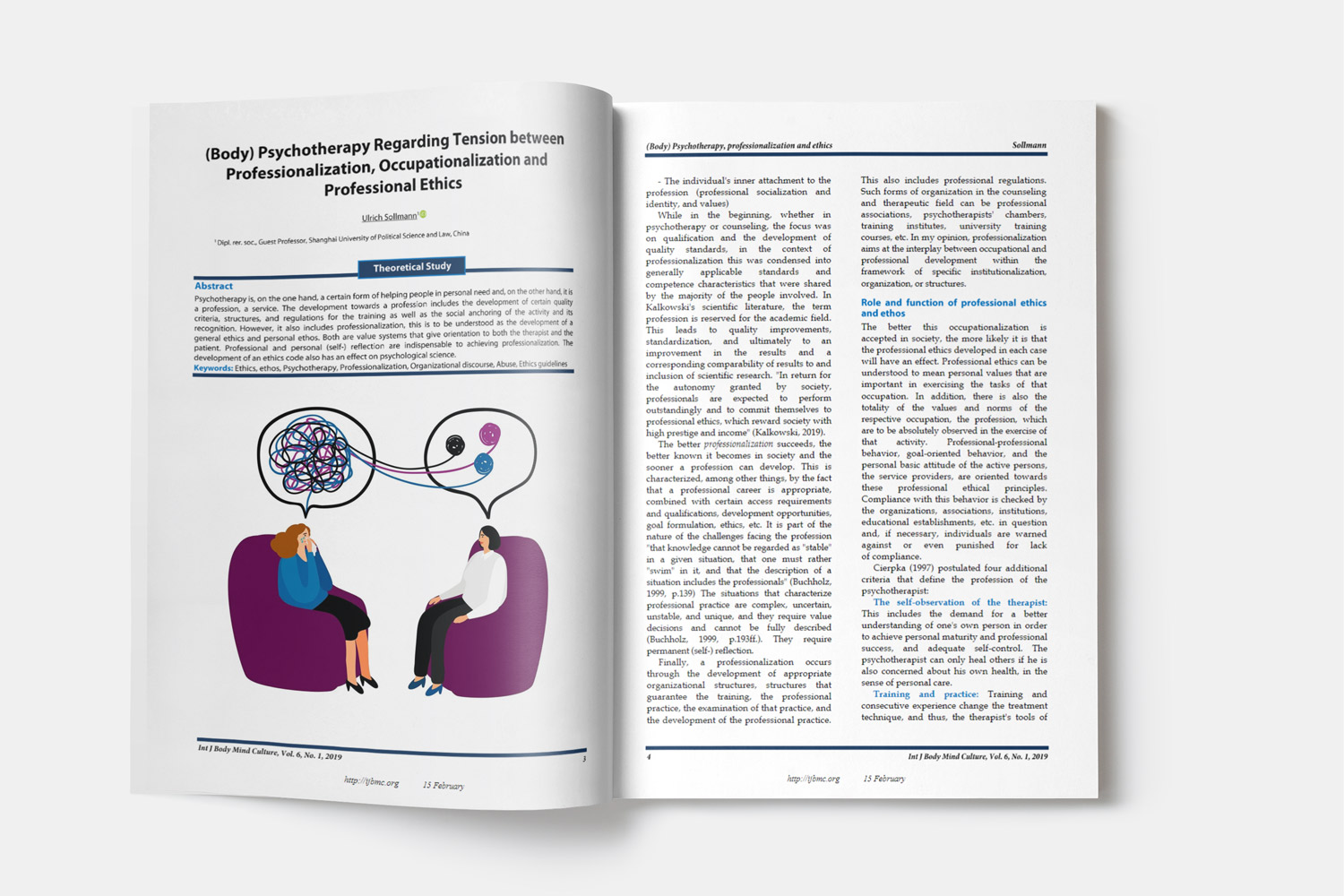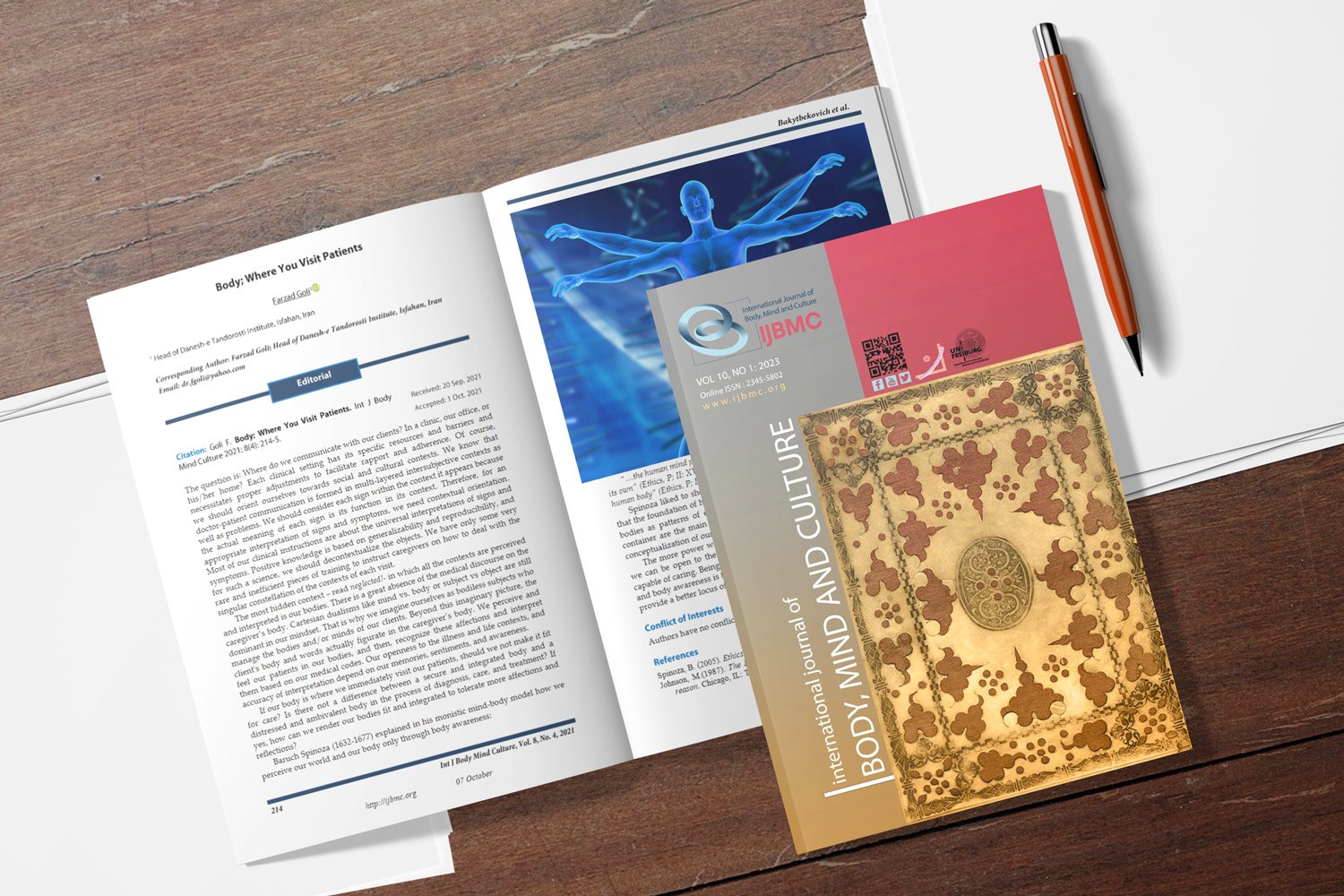Pain Catastrophizing and Attentional Bias among Patients with Chronic Back Pain in Isfahan, Iran: A Comparative Study
Downloads
Background: Chronic back pain accounts for 70 to 85% of all kinds of chronic pain. Chronic back pain is recognized as the third most common disease among Iranians aged between 15 and 69 years. According to previous studies, psychological aspects of pain perception are the main reason for referral to clinics. Therefore, the understanding of creating and continuing factors, such as psychological parameters, is necessary for recognizing the procedure affecting the alleviation of disease in its initial stages. This, in turn, leads to preventing the long-term consequences of chronic back pain. This study aimed to compare pain catastrophizing and attentional bias between patients with chronic back pain and healthy individuals in Isfahan, Iran.
Methods: This was a descriptive-analytical study in which 34 patients with chronic back pain and 33 healthy individuals were investigated and compared. All participants completed the Pain Catastrophizing Scale (PCS) and attentional bias was assessed using the dot-probe task.
Results: The average age of participants was 39.40 years ± 9.79, and 38.8% of them were men. Based on the present study findings, there was a significant difference in pain catastrophizing between patients with chronic back pain and the control group. Moreover, the results of attentional bias of the two groups in the incongruent situation of the dot-probe task were significantly different.
Conclusion: This study showed that there was a significant difference in pain catastrophizing and attentional bias between patients with chronic back pain and controls. Furthermore, people with chronic back pain presented attention avoidance.
Downloads
Asmundson, G. J., & Katz, J. (2009). Understanding the co-occurrence of anxiety disorders and chronic pain: state-of-the-art. Depress.Anxiety., 26(10), 888-901. doi:10.1002/da.20600 [doi]. Retrieved from PM:19691031
Baum, C., Huber, C., Schneider, R., & Lautenbacher, S. (2011). Prediction of experimental pain sensitivity by attention to pain-related stimuli in healthy individuals. Percept.Mot.Skills, 112(3), 926-946. doi:10.2466/02.09.22.PMS.112.3.926-946 [doi]. Retrieved from PM:21853779
Carey, T. S., Garrett, J. M., & Jackman, A. M. (2000). Beyond the good prognosis. Examination of an inception cohort of patients with chronic low back pain. Spine.(Phila Pa 1976.), 25(1), 115-120. Retrieved from PM:10647169
Childs, J. D., Cleland, J. A., Elliott, J. M., Teyhen, D. S., Wainner, R. S., Whitman, J. M. et al. (2008). Neck pain: Clinical practice guidelines linked to the International Classification of Functioning, Disability, and Health from the Orthopedic Section of the American Physical Therapy Association. J Orthop.Sports.Phys Ther, 38(9), A1-A34. doi:1454 [pii];10.2519/jospt.2008.0303 [doi]. Retrieved from PM:18758050
Coste, J., Delecoeuillerie, G., Cohen de, L. A., Le Parc, J. M., & Paolaggi, J. B. (1994). Clinical course and prognostic factors in acute low back pain: an inception cohort study in primary care practice. BMJ., 308(6928), 577-580. Retrieved from PM:8148683
Crombez, G., Heathcote, L. C., & Fox, E. (2015). The puzzle of attentional bias to pain: beyond attention. Pain., 156(9), 1581-1582. doi:10.1097/j.pain.0000000000000255 [doi]. Retrieved from PM:26058039
Davoudi, I., Zargar, Y., Mozaffaripour, E., Nargesi, F., & Molah, K. (2012). The Relationship between Pain Catastrophizing, Social Support, pain-related Anxiety, Coping Strategies and Neuroticism, with Functional Disability in Rheumatic patients. Journal of Health Psychology, 1(1), 54-67.
Dear, B. F., Sharpe, L., Nicholas, M. K., & Refshauge, K. (2011). The psychometric properties of the dot-probe paradigm when used in pain-related attentional bias research. J Pain., 12(12), 1247-1254. doi:S1526-5900(11)00680-8 [pii];10.1016/j.jpain.2011.07.003 [doi]. Retrieved from PM:21982721
Dillie, K. S., Fleming, M. F., Mundt, M. P., & French, M. T. (2008). Quality of life associated with daily opioid therapy in a primary care chronic pain sample. J Am.Board.Fam Med., 21(2), 108-117. doi:21/2/108 [pii];10.3122/jabfm.2008.02.070144 [doi]. Retrieved from PM:18343858
Eccleston, C., & Crombez, G. (1999). Pain demands attention: a cognitive-affective model of the interruptive function of pain. Psychol Bull., 125(3), 356-366. Retrieved from PM:10349356
Eccleston, C. (2001). Role of psychology in pain management. Br.J Anaesth., 87(1), 144-152. doi:S0007-0912(17)36351-1 [pii]. Retrieved from PM:11460803
Evers, A. W., Kraaimaat, F. W., Geenen, R., Jacobs, J. W., & Bijlsma, J. W. (2003). Pain coping and social support as predictors of long-term functional disability and pain in early rheumatoid arthritis. Behav Res Ther, 41(11), 1295-1310. doi:S0005796703000366 [pii]. Retrieved from PM:14527529
Fashler, S. R., & Katz, J. (2014). More than meets the eye: visual attention biases in individuals reporting chronic pain. J Pain.Res, 7, 557-570. doi:10.2147/JPR.S67431 [doi];jpr-7-557 [pii]. Retrieved from PM:25285022
Fischer, B., & Weber, H. (1993). Express saccades and visual attention. 2010/02/04(3), 553-567. Retrieved from https://www.cambridge.org/core/article/express-saccades-and-visual-attention/B38F6BA1820BDD8753880DCD2814AC7D. Retrieved from Cambridge University Press.
Franklin, Z. C., Holmes, P. S., Smith, N. C., & Fowler, N. E. (2016). Personality Type Influences Attentional Bias in Individuals with Chronic Back Pain. PLoS.One., 11(1), e0147035. doi:10.1371/journal.pone.0147035 [doi];PONE-D-15-33908 [pii]. Retrieved from PM:26789517
Frymoyer, J. W. (1988). Back pain and sciatica. N.Engl.J Med., 318(5), 291-300. doi:10.1056/NEJM198802043180506 [doi]. Retrieved from PM:2961994
Gatchel, R. J., Peng, Y. B., Peters, M. L., Fuchs, P. N., & Turk, D. C. (2007). The biopsychosocial approach to chronic pain: scientific advances and future directions. Psychol Bull., 133(4), 581-624. doi:2007-09203-002 [pii];10.1037/0033-2909.133.4.581 [doi]. Retrieved from PM:17592957
Haggman, S. P., Sharpe, L. A., Nicholas, M. K., & Refshauge, K. M. (2010). Attentional biases toward sensory pain words in acute and chronic pain patients. J Pain., 11(11), 1136-1145. doi:S1526-5900(10)00359-7 [pii];10.1016/j.jpain.2010.02.017 [doi]. Retrieved from PM:20797918
Hansen, Z., Daykin, A., & Lamb, S. E. (2010). A cognitive-behavioural programme for the management of low back pain in primary care: a description and justification of the intervention used in the Back Skills Training Trial (BeST; ISRCTN 54717854). Physiotherapy., 96(2), 87-94. doi:S0031-9406(09)00125-4 [pii];10.1016/j.physio.2009.09.008 [doi]. Retrieved from PM:20420955
Indahl, A., Velund, L., & Reikeraas, O. (1995). Good prognosis for low back pain when left untampered. A randomized clinical trial. Spine.(Phila Pa 1976.), 20(4), 473-477. Retrieved from PM:7747232
Jensen, M. P., Keefe, F. J., Lefebvre, J. C., Romano, J. M., & Turner, J. A. (2003). One- and two-item measures of pain beliefs and coping strategies. Pain., 104(3), 453-469. doi:S0304395903000769 [pii]. Retrieved from PM:12927618
Keogh, E., Thompson, T., & Hannent, I. (2003). Selective attentional bias, conscious awareness and the fear of pain. Pain., 104(1-2), 85-91. doi:S0304395902004682 [pii]. Retrieved from PM:12855317
Khan, R. S., Ahmed, K., Blakeway, E., Skapinakis, P., Nihoyannopoulos, L., Macleod, K. et al. (2011). Catastrophizing: a predictive factor for postoperative pain. Am.J Surg., 201(1), 122-131. doi:S0002-9610(10)00238-2 [pii];10.1016/j.amjsurg.2010.02.007 [doi]. Retrieved from PM:20832052
Koleck, M., Mazaux, J. M., Rascle, N., & Bruchon-Schweitzer, M. (2006). Psycho-social factors and coping strategies as predictors of chronic evolution and quality of life in patients with low back pain: a prospective study. Eur.J Pain., 10(1), 1-11. doi:S1090-3801(05)00004-2 [pii];10.1016/j.ejpain.2005.01.003 [doi]. Retrieved from PM:16291293
Lariviere, C., Bilodeau, M., Forget, R., Vadeboncoeur, R., & Mecheri, H. (2010). Poor back muscle endurance is related to pain catastrophizing in patients with chronic low back pain. Spine.(Phila Pa 1976.), 35(22), E1178-E1186. doi:10.1097/BRS.0b013e3181e53334 [doi]. Retrieved from PM:20881658
Lee, G. K., Chronister, J., & Bishop, M. (2008). The Effects of Psychosocial Factors on Quality of Life Among Individuals With Chronic Pain. Rehabilitation Counseling Bulletin, 51(3), 177-189. doi:doi: 10.1177/0034355207311318.
Linton, S. J., Boersma, K., Jansson, M., Svard, L., & Botvalde, M. (2005). The effects of cognitive-behavioral and physical therapy preventive interventions on pain-related sick leave: a randomized controlled trial. Clin J Pain., 21(2), 109-119. doi:00002508-200503000-00001 [pii]. Retrieved from PM:15722803
Linton, S. J., Nicholas, M. K., MacDonald, S., Boersma, K., Bergbom, S., Maher, C. et al. (2011). The role of depression and catastrophizing in musculoskeletal pain. Eur.J Pain., 15(4), 416-422. doi:S1090-3801(10)00205-3 [pii];10.1016/j.ejpain.2010.08.009 [doi]. Retrieved from PM:20884261
Liossi, C., White, P., & Schoth, D. E. (2011). Time-course of attentional bias for threat-related cues in patients with chronic daily headache-tension type: evidence for the role of anger. Eur.J Pain., 15(1), 92-98. doi:S1090-3801(10)00109-6 [pii];10.1016/j.ejpain.2010.05.008 [doi]. Retrieved from PM:20594880
Meyer, K., Tschopp, A., Sprott, H., & Mannion, A. F. (2009). Association between catastrophizing and self-rated pain and disability in patients with chronic low back pain. J Rehabil.Med., 41(8), 620-625. doi:10.2340/16501977-0395 [doi]. Retrieved from PM:19565155
Miller, L. R., & Cano, A. (2009). Comorbid chronic pain and depression: who is at risk? J Pain., 10(6), 619-627. doi:S1526-5900(09)00008-X [pii];10.1016/j.jpain.2008.12.007 [doi]. Retrieved from PM:19398383
Mousavi, S. J., Akbari, M. E., Mehdian, H., Mobini, B., Montazeri, A., Akbarnia, B. et al. (2011). Low back pain in Iran: a growing need to adapt and implement evidence-based practice in developing countries. Spine.(Phila Pa 1976.), 36(10), E638-E646. doi:10.1097/BRS.0b013e3181fa1da2 [doi]. Retrieved from PM:21270691
Nicholas, M. K., Asghari, A., & Blyth, F. M. (2008). What do the numbers mean? Normative data in chronic pain measures. Pain., 134(1-2), 158-173. doi:S0304-3959(07)00189-3 [pii];10.1016/j.pain.2007.04.007 [doi]. Retrieved from PM:17532138
Pincus, T., & Morley, S. (2001). Cognitive-processing bias in chronic pain: a review and integration. Psychol Bull., 127(5), 599-617. Retrieved from PM:11548969
Richardson, E. J., Ness, T. J., Doleys, D. M., Banos, J. H., Cianfrini, L., & Richards, J. S. (2009). Depressive symptoms and pain evaluations among persons with chronic pain: catastrophizing, but not pain acceptance, shows significant effects. Pain., 147(1-3), 147-152. doi:S0304-3959(09)00507-7 [pii];10.1016/j.pain.2009.08.030 [doi]. Retrieved from PM:19773126
Schoth, D. E., Nunes, V. D., & Liossi, C. (2012). Attentional bias towards pain-related information in chronic pain; a meta-analysis of visual-probe investigations. Clin Psychol Rev., 32(1), 13-25. doi:S0272-7358(11)00157-7 [pii];10.1016/j.cpr.2011.09.004 [doi]. Retrieved from PM:22100743
Sharpe, L. (2014). Attentional biases in pain: more complex than originally thought? Pain., 155(3), 439-440. doi:S0304-3959(13)00668-4 [pii];10.1016/j.pain.2013.12.020 [doi]. Retrieved from PM:24342463
Sullivan, M. J., Thorn, B., Haythornthwaite, J. A., Keefe, F., Martin, M., Bradley, L. A. et al. (2001). Theoretical perspectives on the relation between catastrophizing and pain. Clin J Pain., 17(1), 52-64. Retrieved from PM:11289089
Taylor, A. M., Harris, A. D., Varnava, A., Phillips, R., Hughes, O., Wilkes, A. R. et al. (2016). Neural responses to a modified Stroop paradigm in patients with complex chronic musculoskeletal pain compared to matched controls: an experimental functional magnetic resonance imaging study. BMC.Psychol, 4, 5. doi:10.1186/s40359-016-0109-4 [doi];10.1186/s40359-016-0109-4 [pii]. Retrieved from PM:26833066
Todd, J., Sharpe, L., Johnson, A., Nicholson, P. K., Colagiuri, B., & Dear, B. F. (2015). Towards a new model of attentional biases in the development, maintenance, and management of pain. Pain., 156(9), 1589-1600. doi:10.1097/j.pain.0000000000000214 [doi];00006396-201509000-00006 [pii]. Retrieved from PM:26291997
Tripp, D. A., VanDenKerkhof, E. G., & McAlister, M. (2006). Prevalence and determinants of pain and pain-related disability in urban and rural settings in southeastern Ontario. Pain.Res Manag., 11(4), 225-233. Retrieved from PM:17149455
Turk, D. C., Dworkin, R. H., Revicki, D., Harding, G., Burke, L. B., Cella, D. et al. (2008). Identifying important outcome domains for chronic pain clinical trials: an IMMPACT survey of people with pain. Pain., 137(2), 276-285. doi:S0304-3959(07)00503-9 [pii];10.1016/j.pain.2007.09.002 [doi]. Retrieved from PM:17937976
Van Damme, S., Legrain, V., Vogt, J., & Crombez, G. (2010). Keeping pain in mind: a motivational account of attention to pain. Neurosci.Biobehav.Rev., 34(2), 204-213. doi:S0149-7634(09)00007-4 [pii];10.1016/j.neubiorev.2009.01.005 [doi]. Retrieved from PM:19896002
Vlaeyen, J. W., & Linton, S. J. (2000). Fear-avoidance and its consequences in chronic musculoskeletal pain: a state of the art. Pain., 85(3), 317-332. doi:S0304395999002420 [pii]. Retrieved from PM:10781906
Wideman, T. H., Adams, H., & Sullivan, M. J. (2009). A prospective sequential analysis of the fear-avoidance model of pain. Pain., 145(1-2), 45-51. doi:S0304-3959(09)00246-2 [pii];10.1016/j.pain.2009.04.022 [doi]. Retrieved from PM:19477072
Woud, M. L., Zhang, X. C., Becker, E. S., Zlomuzica, A., & Margraf, J. (2016). Catastrophizing misinterpretations predict somatoform-related symptoms and new onsets of somatoform disorders. J Psychosom.Res, 81, 31-37. doi:S0022-3999(15)30027-1 [pii];10.1016/j.jpsychores.2015.12.005 [doi]. Retrieved from PM:26800636
Yang, Z., Jackson, T., Gao, X., & Chen, H. (2012). Identifying selective visual attention biases related to fear of pain by tracking eye movements within a dot-probe paradigm. Pain., 153(8), 1742-1748. doi:S0304-3959(12)00313-2 [pii];10.1016/j.pain.2012.05.011 [doi]. Retrieved from PM:22717101















